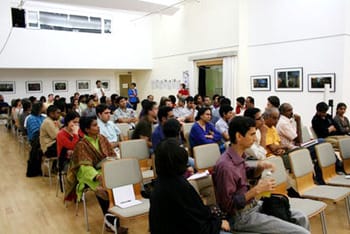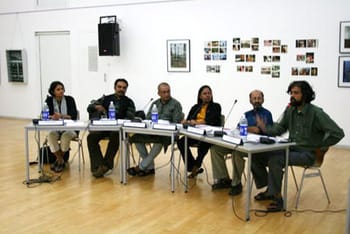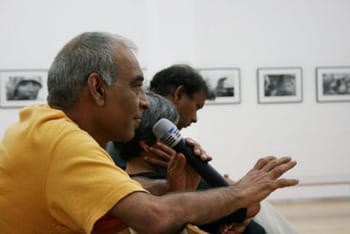‘.. in a democracy such as ours, people make their own meanings of urban space, in both physical-material and mental-imaginative ways.’
‘…negotiations contribute to the production of space in the city and any understanding in the changes of urban morphology goes well beyond, or below, the two dimensionality of the map.’
– Janaki Nair, in The Promise of the Metropolis: Bangalore’s Twentieth Century.
The Bangalore City Corporation (1949) is the result of a union between Bangalore City (the present old city area or pete which was founded in the 16th century) and Cantonment (which was established in the 20th century under the colonial rule). Over the years the city has seen a boom in the IT sector, especially after 1991.
The twin processes of urbanisation and globalisation have led to a change in the overall social, cultural, political and economic structures. On one hand there was a forgetting of cultures, histories, traditions, rituals, etc. and on the other there was a visible increase in the urban poor, slum dwellers and other citizens outside of the city development projects.
In this context, there is much debate surrounding the politics of ‘public space’- the meaning, re-interpreted and contested, is constantly evolving. There is an attempt to find answers to questions like who has access to such space, who constitutes the ‘public’, how does the ‘public’ claim such space, what kind of activity can be undertaken, etc. It is also important to notice the gulf, for instance, in the way in which ‘public space’ is conceptualized by the planner, designer, bureaucrat, economist; the ones who oversee the building of a cityscape and ‘space’ as conceptualized by different social communities based on their lived realities.
In this set up, citizens feel the need to have a say in the way in which the city shapes itself. Also, there is a continual need to find ways to rejuvenate a sense of belonging to the city. The Max Mueller Bhavan (MMB)/Goethe Institut (second name spelt without the ‘e’), Bangalore organised a panel discussion on 26 July, as a culmination of the recently concluded Bangalore City Project (BCP) Urban Space Events in Gavipuram, Whitefield, Old City and Hessarghatta.
The meeting happened a day after the bomb blasts, but that did not impact it; the hall was nearly full. An exhibition of photos – ‘Telling portraits of Urban Change in India’ provided a backdrop for the discussion. The photographers featured were Clare Arni, Vivek M and Mahesh Shantaram from Bangalore and Sohail Abdullah from Pakistan.

Citizens at the meeting (Pic: Rithesh Swamy)
The panel included the organisers of the walks; Dr Chandra Shekar Balachandran, cultural geographer and Director of Indian Institute for Geographical Studies; Champaka Rajagopal, urban planner and a graduate from the University of Berkeley, California; Krupa Rajangam, architect with UDBHAVA; Sathya Prakash Varanashi, architect and founder of UDBHAVA; Suresh Jayaram, artist, art critic and art historian; S Vishwanath, Rainwater Harvesting Club and Arghyam.
Different strokes
While a few were cynical about the contemporary context, there were the idealists as well. Few accepted modernity as inevitable and were accommodative of transformations while the romantics constantly harked on a utopian past. Incidents were narrated, ideas suggested and promises for contribution in terms of actions were also made.

Panelists at the meeting (Pic: Rithesh Swamy)
Sathya Prakash, who organized the walk at Gavipuram, marked the tone for the discussion, “Many of us live in a city but the city doesn’t live in us.” The idealist said he participated in the event because he believed that the city had more potential than problems. He was contemptuous about the fact that most of us looked at cities only for economic benefits, and emphasised on the importance of investing in social welfare activities.
Suresh Jayaram, who was part of the K R Market walk also laid emphasis on artistic interventions in the process of reviving urban spaces. According to him the role of the artist through archiving oral histories, photographs, stories, etc. is to “…relocate spaces and people, to re-document and re-think the city”. He said the focus was on “migration and labour, changing cuisine in the city, changing landscape and also rituals (both secular and sacred)”.
However, Deepak, an artist who was part of the workshop ‘Namma Raste’ which discussed issues pertaining to the road widening project in Bangalore believed that along with artistic intervention, a parallel legal awareness approach was needed.
- Gavipuram, March 8, 2008, coordinated by UDBHAVA
- Whitefield, April 26, 2008, coordinated by UDBHAVA
- Old City Urban Space Event, May 18, 2008, coordinated by Visual Arts Collective, The Indian Institute of Geographical Studies and Groupe Sce India Pvt. Ltd.
- Water Walk to the Hessarghatta Lake, July 6, 2008, coordinated by S. Vishwanath, Rain Water Harvesting Club.
Dr Chandra Shekar Balachandran said the urban space events recaptured and re-imagined landscapes; it also looked at issues in ways in which they were not previously considered. He is involved in an ongoing project called ‘Bangalore Bridges’ which aims at bringing together children within a locality. It uses a multi-arts approach to engage with development issues.
“City DNA locked in language and cuisine”
There was an attempt to address the skewed nature of progress in the city. But there was no mention of the debate surrounding illegal citizens (like slum dwellers, street vendors, beggars, sexual minorities etc.) and their claim to public space. However in the case of the old market area, Champaka Rajagopal highlighted that, top down urban planning practices over the last few decades have effected regulations disparate from necessities of the communities (for instance the Tigala community) in the area. She believes the rule-making process should be negotiated.
KR Market is an area which is marked by linguistic and ethnic diversity, there is multiple bifurcation of plots (the smallest being 1.5 meters by 6 meters). It is the densest area with 1300 persons per hectare, there is the presence of the largest informal economy in the city and also there is the recent politics of occupying the open space outside the old market by vendors due to poor accessibility to the new city market area. Champaka emphasized on the need to have an understanding of the complex dynamics which is involved while mediating within the area. She looked at the manner in which informal economies in the old market area adapt themselves and negotiate with the larger legal and political structures.
Krupa Rajangam who organised the event at Whitefield said the BCP and its members should feel responsible for the areas they are showcasing. She observed that an area like the Anglo-Indian settlement elsewhere in the world would be a highly protected zone but here it’s being torn down.
S Vishwanath noted the ripple effect that the walk to Hessarghatta Lake had on the international community, that similar walks are being planned across the globe. While he appreciated the government’s concept of paying farmers for ecological services and the technological drive initiated by Vishveswaraya, he also noted that there was a blind faith in technology which tended to ignore the ecological and social aspects.
The general sense of alienation felt by city-dwellers needs to be replaced by a sense of belonging and the BCP also wishes to increase the connectivity through activities in the public space. The city’s culture, tradition, cuisine, language, etc., play an important role in this process. As Arundhati Nag, actress and theatre personality who runs Ranga Shankara said, “The DNA of a city is locked in its language and cuisine.”

Citizen asks a question (Pic: Rithesh Swamy)
A sense of helplessness experienced by citizens was also articulated by a few members. For instance Vivek Vaidya, a scientist with General Electrics observed that he once witnessed a cop throw a stone at a BMTC bus that was violating traffic rules. “Every group exists within its own spheres and feels a sense of powerlessness in the public space”, he said.
For a better urban space
On the other hand there was also an attempt to make promises to give back to the city. Like, Anil Kapur, owner of Rex Theatre said there are plans of demolishing the theatre and to build a mall which would be designed like a Victorian monumental structure. His contribution would be by making this mall the ‘greenest building in the city area’. Also, he aims at making HAL II stage where he lives a ‘plastic free zone’ by involving the residents of the locality.
Evelyn Hust, Director of MMB noted, “The city has become a corridor to go as fast as possible or as slow as possible. There is no space for debate.” The first task of the BCP would be to identify unused and vacant spaces in the city, then to re-interpret these spaces in order to decipher possibilities. The BCP is an open platform where citizens can share proposals of urban space and also ideas about how they can be used. It further provides an opportunity to covert these ideas into actions.
Sujith, a resident of Sadashivanagar suggested that the Army has a board and apparently citizens can approach it to gain access to the land that is not used by them for public activities or events. He also suggested that since politicians and private investors also own land, it should be tapped in order to re-use it.
Arundhati Nag offered to open the premises of Ranga Shanakara to be used for discussions and other artistic activities. She suggested we also look at institutions such as the Indian Institute of Science, Indian Institute of Management, etc. as an opportunity to use the campus for events like ‘community art’, wherein a group of artists could work in the open area and the students could participate by watching them.
A few participants expressed a need for a medium (either online or otherwise) which provides space for citizen journalism (www.citizenmatters.in, www.praja.in). This appeal is mostly rooted in the irritation with the contemporary mass media which is sucked into the larger gamut of consumerist culture.
In conclusion Hust said, “We (BCP) are not an exclusive club. A label is just a label. BCP is open to everyone; it’s yours if you want it to be yours”. ⊕